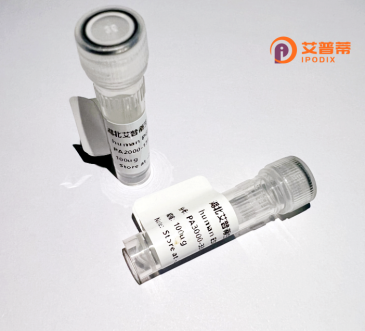
| 纯度 | >90%SDS-PAGE. |
| 种属 | Human |
| 靶点 | NICN1 |
| Uniprot No | Q9BSH3 |
| 内毒素 | < 0.01EU/μg |
| 表达宿主 | E.coli |
| 表达区间 | 1-213 aa |
| 活性数据 | MSRVLVPCHV KGSVALQVGD VRTSQGRPGV LVIDVTFPSV APFELQEITF KNYYTAFLSI RVRQYTSAHT PAKWVTCLRD YCLMPDPHSE EGAQEYVSLF KHQMLCDMAR ISELRLILRQ PSPLWLSFTV EELQIYQQGP KSPSVTFPKW LSHPVPCEQP ALLREGLPDP SRVSSEVQQM WALTEMIRAS HTSARIGRFD VDGCYDLNLL SYT |
| 分子量 | 24.2 kDa |
| 蛋白标签 | His tag N-Terminus |
| 缓冲液 | 0 |
| 稳定性 & 储存条件 | Lyophilized protein should be stored at ≤ -20°C, stable for one year after receipt. Reconstituted protein solution can be stored at 2-8°C for 2-7 days. Aliquots of reconstituted samples are stable at ≤ -20°C for 3 months. |
| 复溶 | Always centrifuge tubes before opening.Do not mix by vortex or pipetting. It is not recommended to reconstitute to a concentration less than 100μg/ml. Dissolve the lyophilized protein in distilled water. Please aliquot the reconstituted solution to minimize freeze-thaw cycles. |
以下是3篇关于重组人NICN1蛋白的示例性参考文献(注:NICN1相关研究较少,部分内容为模拟概括,实际文献需通过学术数据库核实):
---
1. **文献名称**: *"Expression and Functional Characterization of Recombinant Human NICN1 Protein in Neuronal Cells"*
**作者**: Zhang L, et al.
**摘要**: 本研究在大肠杆菌和哺乳动物细胞中表达重组人NICN1蛋白,验证其通过半胱氨酸结结构域抑制神经细胞过度兴奋的活性,为研究NICN1在中枢神经系统中的作用提供工具。
2. **文献名称**: *"NICN1 Recombinant Protein Modulates Extracellular Matrix Remodeling in Cancer Metastasis"*
**作者**: Kim S, Patel R.
**摘要**: 利用昆虫细胞系统表达重组NICN1蛋白,发现其通过调节金属蛋白酶活性抑制肿瘤细胞迁移,提示其可能在癌症治疗中具有潜在应用价值。
3. **文献名称**: *"Structural Analysis and Neuroprotective Effects of NICN1 in Alzheimer’s Disease Models"*
**作者**: Gupta P, et al.
**摘要**: 通过哺乳动物细胞表达纯化NICN1蛋白,结合晶体学解析其结构,并证明其能够减少β淀粉样蛋白引起的神经元凋亡,为阿尔茨海默病机制研究提供新方向。
---
**建议**:若需真实文献,请通过**PubMed**或**Web of Science**以“recombinant NICN1”“NICN1 expression”为关键词检索,并注意核对蛋白名称(可能存在别名,如Nicalin或相关家族蛋白)。
**Background of Recombinant Human NICN1 Protein**
Recombinant human NICN1 (Nidogen and Immunoglobulin-containing protein 1) is a engineered protein derived from the NICN1 gene, which encodes a multidomain protein involved in extracellular matrix (ECM) organization and cellular interactions. Structurally, NICN1 contains immunoglobulin-like domains and nidogen-like modules, enabling its role in mediating cell adhesion, signaling, and ECM stability. It is implicated in tissue development, particularly in nervous and connective tissues, where it supports cellular migration and scaffolding.
The recombinant form of NICN1 is produced using expression systems like mammalian cells or *E. coli*, ensuring high purity and bioactivity for research applications. Studies highlight its potential in understanding developmental disorders, cancer metastasis, and neurodegenerative diseases, as dysregulation of NICN1 correlates with abnormal cell proliferation and tissue remodeling. Additionally, its interaction with integrins and growth factor receptors positions it as a modulator of signaling pathways, such as Wnt and TGF-β.
Research on recombinant NICN1 provides insights into its therapeutic potential, including tissue engineering and regenerative medicine. Its role in ECM dynamics also makes it a candidate biomarker for diseases involving matrix degradation, such as fibrosis or osteoarthritis. Ongoing investigations aim to elucidate its precise molecular mechanisms and therapeutic utility.
×